Intel Whiskey Lake: Everything you need to know about Intel's latest mobile CPUs
Intel has formally abandoned its annual “tick-tock” upgrade schedule, but it’s still coming out with regular updates to its various CPU families. Last October saw the arrival of its eighth-generation Coffee Lake desktop processors ; now the lightweight mobile CPU roster has been brought up to date with two new cores, codenamed Whiskey Lake and Amber Lake respectively. So what do the new designs bring – and if you’re in the market for a new laptop, are they worth waiting for?
Intel Whiskey Lake and Amber Lake: What you need to know
The new chips are built on the same basic 14nm process that Intel’s been using since 2015 – as yet, the company hasn’t managed to ramp up its 10nm processes sufficiently for a mainstream roll-out. They’re also based on the same Kaby Lake architecture that was introduced in 2016, so if you’re looking for major new features, you’re going to be disappointed.
Even the branding isn’t new: the new processors are being advertised as eighth-generation chips, but Intel already released a range of “8th-gen” mobile CPUs at the start of this year. The major difference is that these ones come with faster clock speeds and upgraded Wi-Fi; to distinguish them from the previously released chips, they’ll be marketed with the words “OPTIMIZED FOR CONNECTIVITY” underneath the Intel Core logo.
Intel Whiskey Lake and Amber Lake: Product range
The new mobile line-up has six members, divided into two families. The three Whiskey Lake processors are what Intel calls “U-class” CPUs, with a 15W TDP that’s suitable for your typical slim-but-serious laptop. The Amber Lake models, with their tiny 5W TDP, are aimed more at ultra-thin, fanless devices: a few years ago, they would have come under the Core m brand, and indeed for some reason the most lightweight model still hangs onto to the Core m3 name. More generally, though, these are what Intel now calls “Y-class” processors.
Model | Architecture | Process | Base speed | Max turbo speed | Cores | Hyper-Threading | L3 cache |
Core m3-8100Y | Amber Lake | 14nm | 1.1GHz | 3.4GHz | 2 | Y | 4MB |
Core i5-8200Y | Amber Lake | 14nm | 1.3GHz | 3.9GHz | 2 | Y | 4MB |
Core i7-8500Y | Amber Lake | 14nm | 1.5GHz | 4.2GHz | 2 | Y | 4MB |
Core i3-8145U | Whiskey Lake | 14nm | 2.1GHz | 3.9GHz | 2 | Y | 4MB |
Core i5-8265U | Whiskey Lake | 14nm | 1.6GHz | 3.9GHz | 4 | Y | 6MB |
Core i7-8565U | Whiskey Lake | 14nm | 1.8GHz | 4.6GHz | 4 | Y | 8MB |
Although the process and core design are the same, the new processors manage to hit slightly higher speeds than the previous batch of “8th-Gen” processors: the Core i3-8130U and Core i5-8250U both had maximum turbo speeds of 3.4GHz, which their new replacements raise to 3.9GHz, and the Core i7-8565U gains an extra 400MHz over the previous top-tier Core i7-8650U.
Of course, merely comparing frequencies doesn’t tell the whole story: caches and core counts also vary between models, and the thermal design of the laptop itself plays a big part in determining what speeds the CPU actually hits. If you’re wondering which processor is right for you, your best bet is to check benchmark scores for the specific system you’re interested in.
Intel Whiskey Lake and Amber Lake: Features
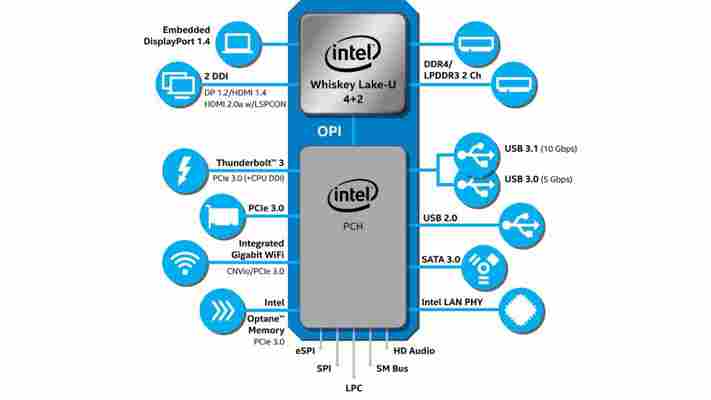
The big thing that’s new in Whiskey Lake and Amber Lake is the “Gigabit Wi-Fi controller” built into the chipset. It’s a 2x2 MIMO 802.11ac radio with 160MHz support for a theoretical bandwidth of 1,733Mbits/sec – twice what Intel’s older platforms offer. That should ensure the fastest possible connection to your router, although of course for many pursuits the speed of your internet connection is going to be the bottleneck.
There’s also now support for two second-generation 10Gbits/sec USB 3.1 connectors, up from one on older chipsets. Thunderbolt 3 remains too, allowing 40Gbits/sec transfers as well as power and video connections on a single cable.
Graphics are provided by the same UHD 620 GPU as found in the last batch of “8th-Gen” mobile processors, and since Intel hasn’t said anything about clock speeds we can assume there’s been no improvement there. Still, with support for up to three simultaneous 4K displays, there’s more than enough graphical power here for any sort of productivity role.
Intel Whiskey Lake and Amber Lake: Price and competition
There’s no pricing information on the new CPUs as yet, but that’s somewhat academic as you won’t be buying these processors in isolation anyway. The question is whether laptops equipped with these new CPUs will cost more than their predecessors – and there’s reason to be optimistic. Since Intel has produced these chips using existing 14nm manufacturing processes, there’s no huge investment to recoup, and laptop manufacturers should be able to incorporate them into new systems without having to completely overhaul their designs.
As for competition, well, it’s possible that AMD will come out with some rival processors based on its Zen+ core – the one that powers its highly successful second-generation Ryzen processors . So far though the red team seems to be focusing on the desktop; it’s only produced a handful of mobile CPUs in recent years, and manufacturers have almost exclusively stuck with Intel.
READ NEXT: How to extend your Wi-Fi range
Intel Whiskey Lake and Amber Lake: Verdict
It’s hard to get too excited about these new chips. Once again, Intel has failed to deliver the 10nm processors that were supposed to be with us years ago, instead tiding us over with a very minor, incremental upgrade.
Still, it is an upgrade. The new eighth-generation laptop CPUs are faster than previous models, if only by a little, and it’s great to see Gigabit Wi-Fi becoming standard. We shouldn’t have to wait long to see the benefit either, with manufacturers are already starting to announce machines based on the new chips.
If you don’t need to buy a new laptop right this second, therefore, it’s probably worth holding out to see if you can pick up one of Intel’s latest CPUs. A major step forward this isn’t, but if you can get the new generation for the same price as the old one, you might as well.
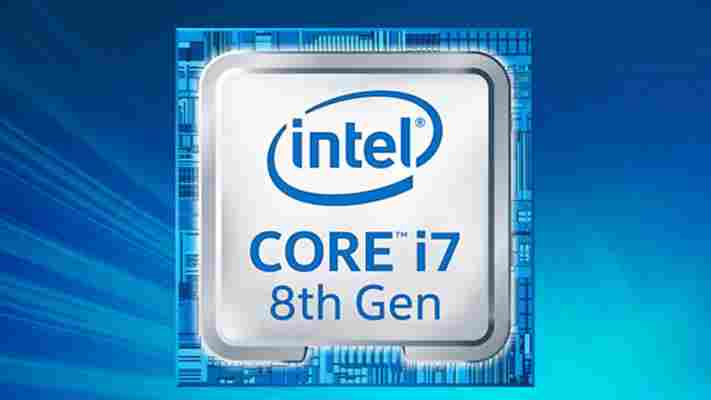

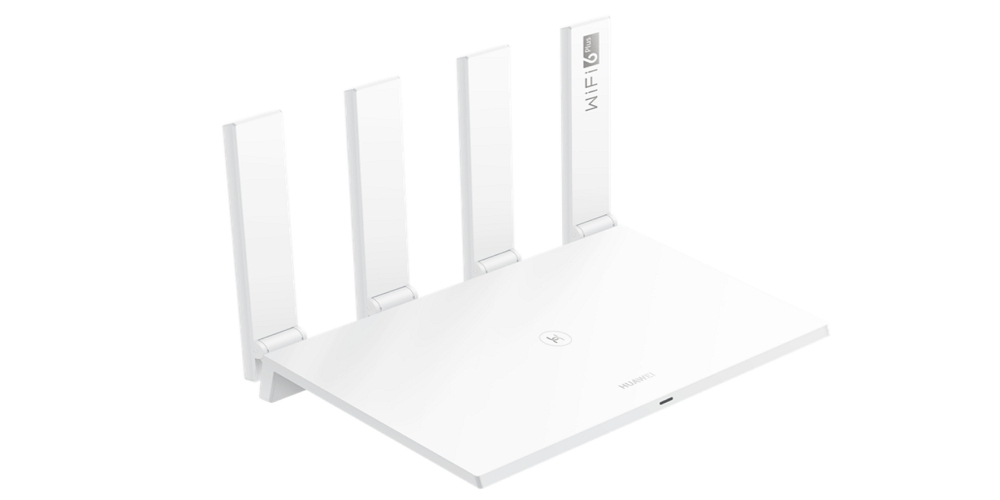
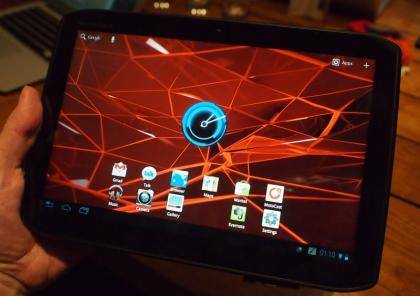
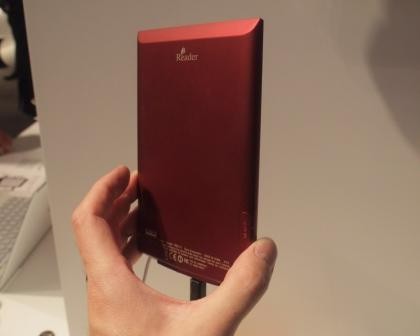
Leave a Comment